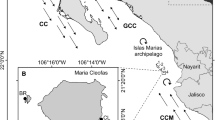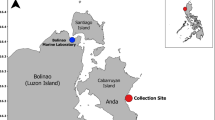Summary
The temperate water coral, Astrangia lajollaensis broadcasts a large number of small eggs. It propagates asexually by budding and regeneration, and forms two-dimensional colonies on hard rocky substrate. Sexual recruitment was absent and asexual propagation was slow during this study. I conclude that budding at the borders of colonies is not slowed by the presence of adjacent space competitors nor is it enhanced by their absence. A model of colony growth is presented and ages of colonies at the study site are predicted. The ecological roles of sexual and asexual reproduction in the kelp forest habitat of A. lajollaensis are discussed. The occurrence of A. lajollaensis population at a study site in Pacific Grove, California extends the northern range for the species. The nearest conspecifics are 200–300 km to the south. Establishment of this northern population probably occurred by settlement of planktonic planulae but the long-term persistence of the population may be possible only by the strategy of asexual propagation and regeneration.
Similar content being viewed by others
References
Bak RPM, Engel MS (1979) Distribution, abundance and survival of juvenile hermatypic corals (Scleractinia) and the importance of life-history strategies in the parent coral community. Mar Biol 54:341–352
Birkeland C (1977) The importance of rate of biomass accumulation in early successional communities to the survival of coral recruits. In: DL Taylor (ed) Proceedings of the Third International Symposium on Coral Reefs, pp 15–21. School of Marine and Atmospheric Sciences, University of Miami
Bucklin A (1980) The reproduction and population biology of Metridium (Coelenterata, Actiniaria). PhD Diss, Univ Calif Berkeley, 181 pp
Chia F-S (1976) Sea anemone reproduction: patterns and adaptive radiations. In: GO Mackie (ed) Coelenterate ecology and behavior, pp 261–270. New York, Plenum Press
Connell JH (1973) Population ecology of reef corals. In: OA Jones, R Endean (eds) Biology and geology of coral reefs. Vol 2, Biol 1, pp 205–245. New York, Academic Press
Durham JW (1947) Corals from the Gulf of California and the North Pacific Coast of America. Geol Soc Amer Mem 20:68 pp
Durham JW, Barnard JL (1952) Stony corals of the Eastern Pacific collected by the the Velero III and Velero IV. Allan Hancock Pacific Expeditions: 16(1):110 pp
Fadlallah Y (1981) The reproductive biology of three species of corals from central California, 193 pp. Ph D Thesis. University of California, Santa Cruz
Francis L (1973) Clone specific segregation in the sea anemone Anthopleura elegantissima. Biol Bull 144:64–72
Francis L (1979) Contrast between solitary and clonal life styles in the sea anemone Anthopleura elegantissima. Amer Zool 19:669–681
Garrison DL (1979) Monterey Bay phytoplankton. I. Seasonal cycles of phytoplankton assemblages. J Plankton Res 1(3):241–265
Gerrodette T (1981) Dispersal of the solitary coral Balanophyllia elegans by demersal planulae larvae. Ecology 62(3):611–619
Glesener RR (1979) Recombination in aimulated predator-prey interaction. Am Zool 19:763–771
Glesener RR, Tilman D (1978) Sexuality and the component of environmental uncertainty. Am Nat 112:659–673
Highsmith RC (1980) Passive colonization and asexual colony multiplication in the massive coral Porites lutea Milne Edwards and Haime. J Exp Mar Biol Ecol 47:55–67
Hoffman RJ (1976) Genetics and Sexual Reproduction of the sea anemone Metridium senile. Biol Bull 151:478–488
Kackson GA, Strathmann RR (1981) Larval mortality from offshore mixing as a link between precompetent and competent periods of development. Am Nat 118(1):16–25
Jackson JBC (1977/78) Competition on marine hard substrata: the adaptive significance of solitary and colonial strategies. Am Nat 11(980):743–767
Kaufmann KW (1981) Fitting and using growht curves. Oecologia 49:293–299
Kojis BL, Quinn NJ (1981) Aspects of sexual reproduction and larval development in the shallow water hermatypic coral Goniastrea australensis (Edwards and Haime, 1857) Bull Mar Sci 31(3)
Lang J (1973) Interspecific aggression by scleractinian corals. Why the race is not only to the swift. Bull Mar Sci 23:260–279
Palmer AR, Strathmann RR (1981) Scale of dispersal in varying environments and its implications for life histories of marine invertebrates. Oecologia 15:93–120
Pearse JS, Lowry LF (1974) An annotated species list of the benthic algae and invertebrates in the kelp forest community at Point Carbrillo, Pacific Grove, California. Coastal Mar Lab, University of California Tech Rep 1:73 pp
Porter JW (1976) Autotrophy, heterotrophy and resource partitioning in the Caribbean reef-building corals. Am Nat 110:731–742
Sebens KP (1977) Habitat suitability, reproductive ecology, and the plasticity of body size in two sea anemone populations (Anthopleura elegantissima and A. xanthogrammia). Ph D Diss, Univ of Washington, Seattle
Sebens KP (1979) The energetics of asexual reproduction and colony formation in benthic marine invertebrates. Am Zool 19:683–697
Shick JM, Hoffman RJ, Lamb AN (1979) Asexual reproduction, population structure and genotype-environment interactions in sea anemones. Am Zool 19:699–713
Squires DF (1959) Results of the Puritan-American Museum of Naturla History Expedition to western Mexico. 7. Corals and coral reefs in the Gulf of California. Bull Amer Museum Nat Hist 118(7)
Stimson JS (1978) Mode and timing of reproduction in some common hermatypic corals from Hawaii and Enewetak. Mar Biol 48:173–184
Strathamann RR (1974) The spread of sibling larvae of sedentary marine invertebrates. Am Nat 108(959):29–44
Strathmann RR, Strathmann MF (1982) The relationship between adult size and brooding in marine invertebrates. Am Nat 119(1):91–101
Tunnicliffe V (1981) Breakage and propagation of the stony coral Acropora cervicornis. Proc Natl Acad Sci 78(4):2427–2431
Vance RR (1973) On reproductive strategies in marine benthic invertebrates. Am Nat 107(5):939–952
Vaughan TW, Wells TW (1943) Revision of the suborders, families and genera of the Scleractinia. Spec Pap Geol Soc Am 44:1–336
Wells JW (1956) Scleractinia. In: RC Moore (ed) Treatise on Invertebrate Paleontology, pp 328–444. Geological Society of America and University of Kansas Press
Williams GC (1975) Sex and evolution. Monographs in population biology 8:200 pp. Princeton
Author information
Authors and Affiliations
Rights and permissions
About this article
Cite this article
Fadlallah, Y.H. Reproductive ecology of the coral Astrangia lajollaensis: Sexual and asexual patterns in a kelp forest habitat. Oecologia 55, 379–388 (1982). https://doi.org/10.1007/BF00376926
Received:
Issue Date:
DOI: https://doi.org/10.1007/BF00376926




